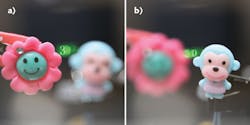See-through 3D head-mounted display uses wavefront modulation and holographic gratings
By taking advantage of the fact that all of the depth cues of a three-dimensional (3D) object are contained in the complex wavefront of that object, researchers at the Beijing Institute of Technology (Beijing, China) have developed a see-through 3D head-mounted display using compact optics that essentially eliminates the viewer fatigue that so often plagues these head-worn technologies.
Unlike two-hologram interference, cascaded holograms, and modified iteration algorithms that require at least two spatial light modulators (SLMs) and bulky crystals or additional filtering, the grating filter method applied by the researchers needs only a grating and a 4f lens system to reconstruct the complex wavefront. Essentially, a laser illuminates a SLM (1920 × 1080 pixels with an 8 μm pixel pitch) through a beamsplitter and the beam then passes to the 4f system consisting of two lenses with a grating at the back focus of the first lens acting as a frequency filter. A mirror reflects the beam to another beamsplitter that combines the modulated image with the real-world scene for a true see-through display with a compact size of around 134 × 40 × 35 mm. Experimental observation of small 3D objects using the display produces very clear and fatigue-absent images at different focus depths ranging from about 130 to 220 mm. And because the modulation depth range depends on the coherence length of the laser source, typical semiconductor lasers with nanometer linewidths and several-meter coherence lengths are more than sufficient for a realistic 3D experience. Reference: Q. Gao et al., Opt. Express, 25, 7, 8412-8424 (2017).
About the Author

Gail Overton
Senior Editor (2004-2020)
Gail has more than 30 years of engineering, marketing, product management, and editorial experience in the photonics and optical communications industry. Before joining the staff at Laser Focus World in 2004, she held many product management and product marketing roles in the fiber-optics industry, most notably at Hughes (El Segundo, CA), GTE Labs (Waltham, MA), Corning (Corning, NY), Photon Kinetics (Beaverton, OR), and Newport Corporation (Irvine, CA). During her marketing career, Gail published articles in WDM Solutions and Sensors magazine and traveled internationally to conduct product and sales training. Gail received her BS degree in physics, with an emphasis in optics, from San Diego State University in San Diego, CA in May 1986.
